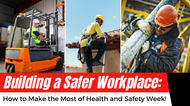
Health and Safety Week in the Workplace: Why It Matters More Than Ever May 5th to 10th
Posted by Safety Supplies Canada on 8th May 2025
Every year, from May 5th to May 10th, workplaces across the country observe Health and Safety Week—an initiative dedicated to promoting a culture of safety, prevention, and responsibility in every industry.
Originally launched as part of North American Occupational Safety and Health (NAOSH) Week, this event began in the late 1990s as a collaborative effort between Canada, the United States, and Mexico to highlight the importance of preventing injury and illness in the workplace. Over time, Health and Safety Week has evolved into a widely recognized event that encourages companies to reevaluate their safety policies and foster a safer work environment for all employees.
The goal of Health and Safety Week isn’t just to raise awareness for a few days—it’s to create lasting change and a proactive safety mindset. Employers are encouraged to use this time to reinforce existing safety protocols, educate staff on risk prevention, and identify areas for improvement. It’s a time to not only comply with regulations but to go beyond the minimum and ensure that safety is embedded into every aspect of daily operations. 
One of the foundational aspects of any workplace safety strategy is conducting a thorough hazard assessment. This process involves identifying potential hazards—whether physical, chemical, biological, or ergonomic—before they cause harm. A comprehensive hazard assessment should consider both routine and non-routine tasks and involve employees at every level. Their insights can be invaluable, especially when identifying overlooked risks. Once hazards are identified, they must be evaluated for their severity and likelihood of occurrence. Then, companies can prioritize corrective actions to eliminate or control those risks.
Another essential pillar of a strong safety strategy is the proper use of personal protective equipment (PPE). All employees should be trained in both general PPE—like hard hats, gloves, safety glasses, and hearing protection—as well as specific PPE tailored to their job roles, such as respiratory protection for those working with hazardous substances or fall protection gear for those working at heights. PPE is the last line of defense against injury, and it must be well-maintained, appropriately selected, and readily available. During Health and Safety Week, companies should take the opportunity to audit their PPE supply, inspect equipment, and conduct refresher training sessions on proper usage. 
Health and Safety Week serves as a reminder that safety is not just a checklist—it’s a mindset. By assessing hazards, investing in PPE, and encouraging active participation in safety practices, companies can reduce accidents, protect workers, and create a workplace where everyone feels safe and supported.
Looking for help in identifying the necessary equipment to keep your workers safe? Call us today! 1-855-960-7369 Our team is ready to assist!
